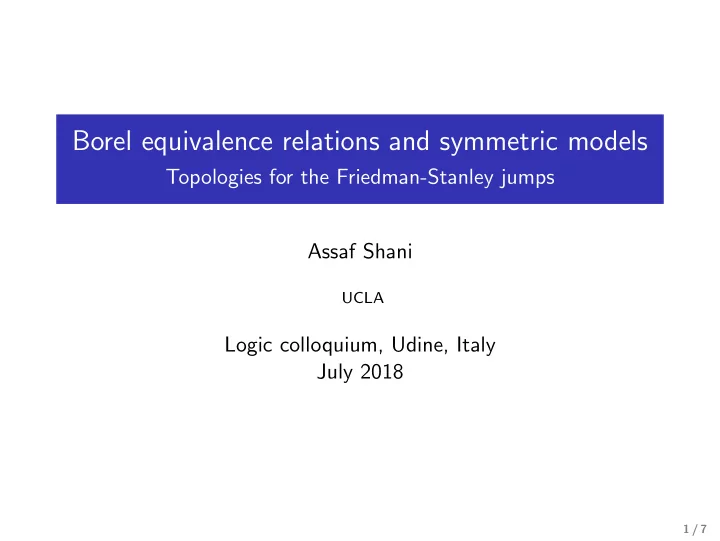

Borel equivalence relations and symmetric models Topologies for the Friedman-Stanley jumps Assaf Shani UCLA Logic colloquium, Udine, Italy July 2018 1 / 7
Motivation Given an equivalence relation E on a Polish space X , how does E behave generically ? Definition (Kanovei-Sabok-Zapletal 2013) An analytic equivalence relation E is in the spectrum of the meager ideal if there is an equivalence relation F on a Polish space Y which is Borel bireducible with E , and furthermore for any non meager set C ⊆ Y , F ↾ C is Borel bireducible with E . Example The dichotomy theorems imply that E 0 , E 1 and E ω 0 are in the spectrum of the meager ideal, witnessed by the natural product topologies on their domains. 2 / 7
Friedman-Stanley jumps Definition = + on R ω is defined by the complete classification � x 0 , x 1 , ... � �→ { x i ; i ∈ ω } . Theorem (Kanovei-Sabok-Zapletal (2013)) Consider R ω with the natural product topology. If C is a comeager set, then = + ↾ C is Borel bireducible to = + . Definition = ++ on R ω 2 is defined by the complete classification � x i , j | i , j < ω � �→ {{ x i , j ; j ∈ ω } ; i ∈ ω } . Question (Zapletal) Is = ++ in the spectrum of the meager ideal? 3 / 7
Results = ++ on R ω 2 is defined by the complete classification � x i , j | i , j < ω � �→ {{ x i , j ; j ∈ ω } ; i ∈ ω } . Question (Zapletal) Is = ++ in the spectrum of the meager ideal? Does = ++ �≤ = + hold on comeager sets? Proposition = ++ is Borel reducible to = + on a comeager subset of R ω 2 . Theorem (S.) = ++ is in the spectrum of the meager ideal. 4 / 7
Borel equivalence relations and symmetric models Theorem (S.) Suppose E and F are Borel equivalence relations on X and Y respectively and x �→ A x and y �→ B y are classifications by countable structures of E and F respectively. Assume that f : X − → Y is a (partial) Borel reduction from E to F . Take x ∈ dom f in some generic extension and let A = A x and B = B f ( x ) . Then V ( A ) = V ( B ) Example Let A ⊆ R be a set of generic Cohen reals (a = + -invariant). The “basic Cohen model” V ( A ) is not of the form V ( r ) for any real r . It follows that = + is not Borel reducible to = R (on any comeager set). 5 / 7
A model of Monro (1973) Let A 1 be the Cohen set as above. Force over V ( A 1 ) to add a set A 2 of infinitely many generic subsets of A 1 . Consider Monro’s model V ( A 1 )( A 2 ) = V ( A 2 ). Proposition V ( A 2 ) � = V ( B ) for any set of reals B . Since A 2 is an = ++ -invariant: Corollary = ++ is not Borel reducible to = + . 6 / 7
Topology for = ++ Consider the equivalence relation F on R ω × (2 ω ) ω defined by the complete classification ( x , z ) �→ {{ x ( j ); z ( i )( j ) = 1 } ; i < ω } . . . . . . . . . . . . . . . . . . . . . . x (3) 1 0 1 x (3) − x (3) . . . . . . �→ x (2) 1 1 0 x (2) x (2) − . . . . . . − x (1) x (1) x (1) 0 1 1 . . . . . . x (0) 0 1 0 − x (0) − . . . . . . F is Borel bireducible with = ++ . Corollary (of previous proof) For any comeager set C ⊆ R ω × (2 ω ) ω , F ↾ C is not Borel reducible to = + . 7 / 7
Recommend
More recommend